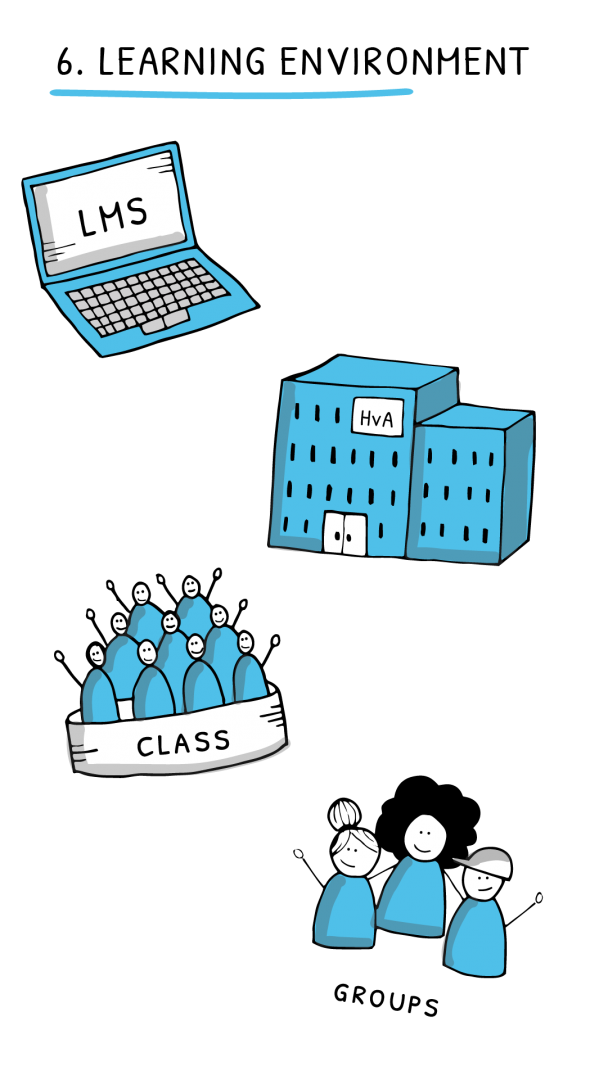Designing the learning environment
Quality education takes place in a structured, well-designed learning environment, both offline and online. The learning environment influences students’ motivation and enables them to take responsibility for their own learning process.
Why?
Students learn, primarily, in the learning environment. It is where they can practise their practical, metacognitive and regulative skills. The physical learning environment and materials must be suited to the assignments within the module. On the other hand, a well-designed digital learning environment prevents overtaxing the working memory, which would result in an excessive cognitive load. The digital learning environment also presents opportunities for offering students flexibility and differentiation. Choices can be made with regard to content (in-depth study or additional exercises), pacing, locations, working methods and media.
What?
Your degree programme has guidelines for designing the learning environment, which also follow from the design of your module. The learning outcomes determine which knowledge and skills students should develop in the learning environment. The required learning environment is determined by content, classes, group size, the weekly rhythm, and flexibilisation and differentiation within the module. Remember to also consider how your students can engage with the outside world via your learning environment.
How?
The learning environment encompasses everything which allows students to achieve learning results. Developing education requires considering the purpose and design of the various environments, such as:
1. The physical learning environment (teaching locations at AUAS and/or elsewhere)
Providing a supportive physical learning environment does not require overhauling your classroom: even a few subtle changes can stimulate students to adapt their behaviour.
- Interaction and debate
Arrange the tables in a U– shape so the students can see each other, or in a House of Commons-type set-up, facing each other, to encourage debate. You can also use a teaching method such as Over de streep (NL) (crossing the line) to have students with different opinions or experiences debate each other. - Dialogue and cooperation
Group tables together in twos or threes, creating islands of tables throughout the classroom. Students can form smaller groups within each island and even change tables if you assign them specific topics. - Brainstorming
You can stick large flip-chart sheets to the walls or use brown paper for students to collect ideas and brainstorm collectively about topics. Make sure there is enough space to stand around a sheet of paper. - Processing
There is growing evidence that movement benefits the brain and information processing and that plants and fresh air contribute to people’s well-being. Instead of having students work together in groups around tables, have them walk and discuss things outdoors. Make clear agreements about outcomes and feedback.
If furniture cannot be moved, you could use digital resources such as Wooclap to initiate interaction. Alternatively, you can encourage debate by asking students to stand up if they agree with a proposition.
2. The digital learning environment (Brightspace, MS Teams and other tools)
In a physical space, it is often immediately clear what purpose objects serve and where students are supposed to sit. Unfortunately, things tend not to be as clear in digital learning environments, where students get lost in a jungle of applications. ‘Are we supposed to submit our assignments in Teams or by email? Should we debate in Slack or in Brightspace? Where do I find the literature and assignments for this course?’
Look at the structure of the digital learning environment through the eyes of the students! To you as a lecturer, things will often seem logical, or you may find a certain tool easier to use than Brightspace or Teams. To students, however, this presents an additional burden: creating yet another account, having to learn how yet another environment works. ‘Less is more’ and ‘keep it simple, stupid’ are popular adages for a reason. Contact the module coordinator and colleagues to coordinate how you will design the digital learning environment.
A well-designed structure helps students find the right activities and materials fast, keep an overview (such as between synchronous and asynchronous activities) and avoid wasting energy. A clear structure is essential for study success (Garrison et al., 1999)
Which structure best suits your course depends on the set-up. For example:
– weekly structure (Week 1, Week 2);
– thematic structure (e.g. Leadership, Communication, Group structure…);
– content structure (Literature, Lectures, Assignments…);
– sprints;
– and so on.
In addition to having a clear structure, students must know at all times what they are supposed to do, when they are supposed to do it and where they can find the relevant materials. It is important, therefore, to give each module a clear name. Also, indicate clearly whether activities are to be done before, during or after a lecture. You can use sub-modules for this in Brightspace.
Also, see a structured digital learning environment (NL) by FOO in Brightspace.
3. The world
What has the learning environment got to do with the world? Everything! Education – at all levels – prepares students for life outside of the classroom. Students in higher professional education like to learn from their teachers’ practical knowledge: theory put into practice. Use everyday examples and case studies and involve experts from the professional field to familiarise students with the real-life application of knowledge. Excursions and work visits can be a stimulating experience for students and provide a better understanding of professional practice and the reasons the profession has added value there.
Of course, work placements and graduations are also learning environments in the real world.
Students can get to know the world outside the Netherlands via Internationalisation@home or a physical exchange. International students in your online or offline classes can also enrich education; in addition to learning course content, students learn to recognise and bridge cultural differences.

